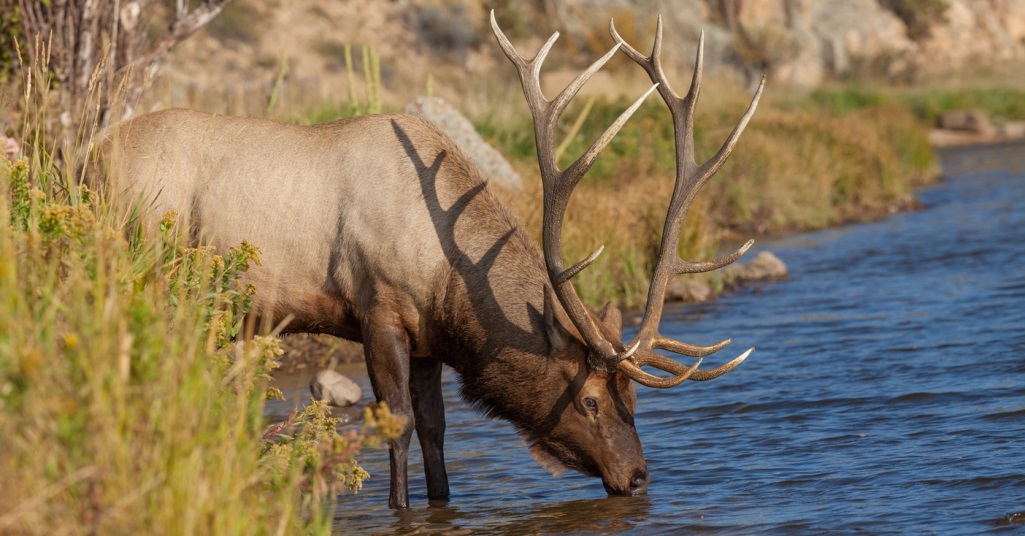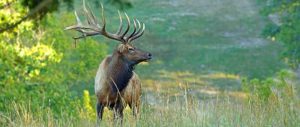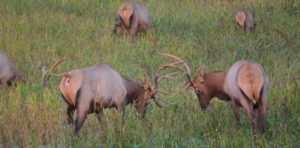On foggy mornings when the chill of fall is in the air, distant elk bugles ring sparsely through the hills and valleys of the East. Each one tells the tale of one of North American wildlife’s greatest recovery stories.
The Rocky Mountain Elk Foundation (RMEF) has been working hard to help that unique, high-pitched sound resonate across lands from the Appalachians to the Ozarks. The Eastern U.S. provides many opportunities to reintroduce the native elk to their historic range, a goal the Rocky Mountain Elk Foundation has been working toward since 1990.
When Europeans came to North America, as many as 10 million elk roamed the U.S. Their numbers proved a plentiful resource that explorers, trappers and settlers depended on for survival. But left unmanaged, unregulated hunting and loss of habitat eventually became too great and elk herds east of the Mississippi disappeared by the late 1800s.
Since then, efforts by hunter-conservationists and state wildlife agencies have restored elk populations across the nation. RMEF believes that making elk restoration programs a priority in the Eastern U.S. will ensure a future where residents and visitors will have the opportunity to wake up to the bugle and listen as the story of triumph continues.
In January of 2018, capture efforts got underway in Arizona as part of a joint effort by the West Virginia Division of Natural Resources (WVDNR), Arizona Game and Fish Commission and the Rocky Mountain Elk Foundation.
“We caught 29 the first day, 25 cows and four bulls. All were fitted with GPS collars, West Virginia ear tags, metal USDA tags, microchips, and we collected DNA samples,” Chris Ryan, WVDNR biologist, told the West Virginia Metro News. “The goal is catch 60 with 50 cows and 10 bulls.”
Wildlife workers on site fired nets to capture the animals, sedated them and then prepared them for a short helicopter ride to a nearby trailer. Once the on-the-ground work wraps up, the elk will be transported some 2,000 miles east to augment continuing restoration efforts in West Virginia.
In Virginia, it was reported in March of 2018 that—five years after being reintroduced onto their native historic range in the Old Dominion State—elk are slowly thriving. “We are allowing nature to do its thing now, they will reproduce on their own,” says David Kalb, Virginia Department of Game and Inland Fisheries (DGIF) project leader. “It’s just a rather slow process. Right now we are seeing good recruitment numbers and we are seeing excellent health in the animals that we have.”
The Rocky Mountain Elk Foundation provided both funding and volunteer manpower as it worked with the DGIF and the Kentucky Department of Fish and Wildlife to relocate Kentucky elk onto reclaimed mine land in Buchanan County in the western part of Virginia. The first reintroduction effort began in 2012 and the last was in 2014. Today, there are approximately 200 elk in the state.
The Four Steps of Elk Restoration
Step 1: Rebuilding Numbers
RMEF has worked to secure habitat and increase elk numbers in the Eastern U.S. since 1990. The goal of increasing the Eastern population is one RMEF has studied and championed for years. Making it a priority will strengthen the work that’s already been done.
- RMEF endorses combined state goals leading to an Eastern elk population of 17,000;
- RMEF has already assisted with elk restoration projects in seven states, Wisconsin, Kentucky, Tennessee, North Carolina, Missouri, Virginia, West Virginia and Ontario, Canada;
- RMEF has invested in feasibility studies in Illinois, New York and Maryland. The state agencies use the study data to determine whether or not to restore elk to their area.
Step 2: Enhancing Habitat
Increasing elk numbers is only part of RMEF’s vision. Bringing back the habitat is an important second phase that will help herds thrive and provide a rich experience for both wildlife watchers and hunters alike.
- In addition to more than 200 habitat projects already completed, RMEF will focus on increasing early successional habitats in the East, as these are the types of lands where elk and other wildlife flourish;
- Enhancing habitat is done with a variety of activities, such as prescribed fire, plantings and mechanical treatment which create resilient landscapes that support numerous native plant and animal species, not just elk;
- Mechanical treatments sometimes produce marketable wood as a byproduct, which could contribute to local economies.
Step 3: Protecting Land
Across six Eastern states, RMEF has improved public access on thousands of acres and protected vital elk habitat on many more. As herds grow, protecting key habitat areas for elk is critical to mitigating crop depredation and agricultural conflict.
- RMEF protects lands by establishing conservation easements, facilitating land exchanges and conducting land acquisitions that allow strategic parcels of private land to be protected from development and open to the public;
- Focus areas may include key habitats such as National Forest System lands and reclaimed private mine lands;
- RMEF has already protected nearly 100,000 acres in the Eastern U.S., land that is valued at more than $21 million.
Step 4: Honoring the Hunt
Protecting our hunting heritage remains an important goal for RMEF. The East offers many hunting opportunities for a variety of species, but there are still many chances to improve those hunting experiences,
- With more people and fewer acres of public hunting lands, the East is an obvious place where RMEF can have an impact to ensure current and future hunters have access to land to hunt;
- Every Eastern state to receive RMEF funding for elk restoration plans to establish a hunting season once the elk population can support it;
- Currently, six Eastern states allow elk hunting and allocate approximately 1,300 licenses (AR, KY, MI, MN, PA, TN).
The Eastern Elk Initiative Is Happening Now
Bolstering the Eastern elk population takes teamwork. The Rocky Mountain Elk Foundation nurtures strong partnerships with many organizations to find the best ways to bring elk and habitat back to Eastern climes.
Arkansas
- Primary Partner: Arkansas Game and Fish Commission;
- Habitat Work: Conduct controlled burns to stimulate forage growth on the Gene Rush Wildlife Management area and Buffalo national River. in 2007, work began on the Ozark national Forest with the Bearcat Hollow project, which could double the size of the elk range;
- Lands: Acquire and protect key lands within and around national Forest System lands in the elk zone.
Kentucky
- Primary Partner: Kentucky Department of Fish and Wildlife Resources;
- Habitat Work: Launch an ambitious multi-year, landscape-scale habitat improvement effort to benefit elk, ruffed grouse and a host of other wildlife.
Michigan
- Primary Partner: Michigan Department of Natural Resources;
- Habitat Work: Mow, seed, plant trees and fertilize within strategically placed forage openings across the Pigeon River State Forest.
Minnesota
- Primary Partner: Minnesota Department of Natural Resources;
- Habitat Work: Perform forage plot maintenance on state wildlife management area lands to attract elk to non-agricultural land. Habitat work is expanding to include key adjacent private lands;
- Elk Restoration: Provide funding and technical assistance to study the feasibility of restoring elk to northeast Minnesota.
North Carolina
- Primary Partner: North Carolina Wildlife Resources Commission;
- Habitat Work: Restore oak and pine woodlands in Great Smoky Mountains national Park and surrounding valleys;
- Lands: Continue partnership to expand and protect lands in the elk zone allowing the herd to grow and move beyond the Great Smoky Mountains national Park.
Pennsylvania
- Primary Partners:Pennsylvania Game Commission and the Department of Conservation and natural Resources;
- Habitat Work: Convert former surface-mined lands to prime wildlife habitat; improving water flow and quality in the process;
- Lands: Acquire and protect priority lands within the elk zone.
Tennessee
- Primary Partner: Tennessee Wildlife Resources Agency;
- Habitat Work: apply herbicide, soil amendments, controlled burning and seeding to maximize forage value within recent RMeF funded forage openings on the north Cumberland Wildlife Management area.
Virginia
- Primary Partner: Virginia Department of Game and Inland Fisheries;
- Habitat Work: Create forage openings and water sources near the release site to encourage elk to stay within the elk restoration zone;
- Lands: Acquire and protect key parcels in this new elk country.
West Virginia
- Primary Partner: West virginia Division of natural Resources;
- Habitat Work: Hydro-seed, treat invasive plants and apply needed soil amendments to provide nutrient rich wildlife forage within the core of the elk restoration zone;
- Elk Restoration: Assist transfer of elk into the state to establish new herd;
- Lands: Protect critical parcels within the elk zone.
Wisconsin
- Primary Partner: Wisconsin Department of Natural Resources;
- Habitat Work: Rejuvenate aspen habitat on the Kimberly Clark Wildlife area and restore high quality forage to historic state and county forest openings within the expanded elk range to improve productivity of newly reintroduced Black River elk herd;
- Lands: Acquire and protect important habitat within and around national Forest System lands in the elk zone;
- Elk Restoration: Assist transfer of elk to Wisconsin from Kentucky to supplement existing Clam Lake elk herd.
Featured photo via Adobe Stock.



